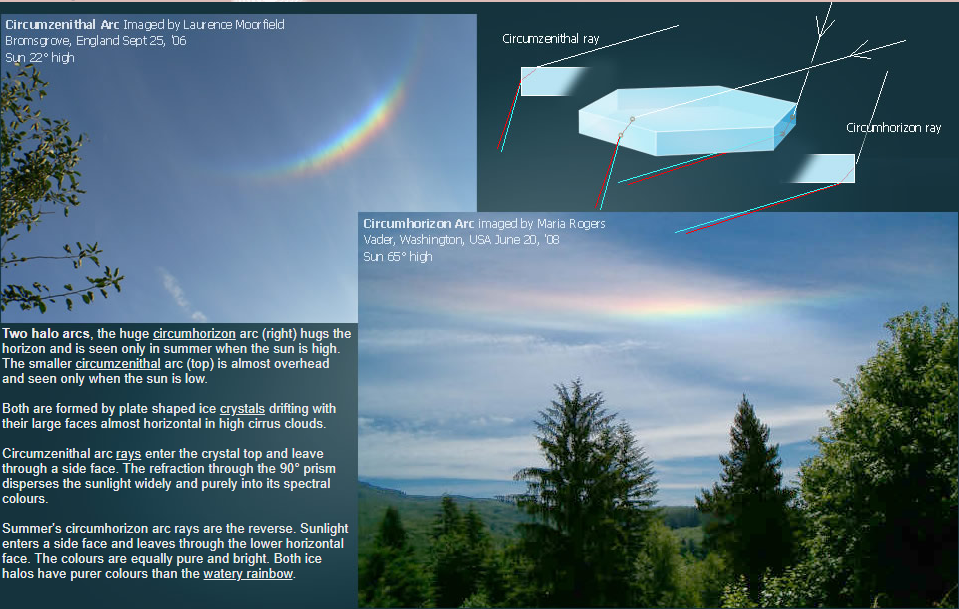Halo Pair
Halo Pair: Exploring the Enchanting Atmospheric Phenomena
Have you ever looked up at the sky and been captivated by the dazzling display of colors surrounding the sun? These vibrant optical phenomena, known as halos, never fail to amaze us with their ethereal beauty. Among the many types of halos that grace our skies, one particularly fascinating duo is the Halo Pair. In this article, we will delve into the intricacies of these mesmerizing atmospheric optics and shed light on their formation and unique characteristics.
The Halo Pair consists of two distinct halo arcs: the circumhorizon arc and the circumzenithal arc. Each of these arcs possesses its own distinct location in the sky and is visible under specific conditions. Let's explore each of these enchanting halos in more detail:
The Circumhorizon Arc: A Spectacular Summer Sight
As its name suggests, the circumhorizon arc appears to encircle the horizon, stretching across the sky like a vibrant band of colors. This awe-inspiring halo is only visible during the summer months when the sun is positioned high in the sky. Its formation relies on the presence of plate-shaped ice crystals drifting in high cirrus clouds. These ice crystals align themselves with their large faces almost parallel to the ground.
When sunlight enters these ice crystals through a side face, it exits through the lower horizontal face. This unique refraction process results in an exquisite dispersion of light, producing pure and brilliantly colored hues. The circumhorizon arc boasts colors that are even purer and more vibrant than those found in a traditional rainbow, which is formed by water droplets instead of ice crystals.
The Circumzenithal Arc: A Majestic Overhead Marvel
In contrast to its counterpart, the circumzenithal arc graces the sky when the sun is low, appearing almost directly overhead. This celestial spectacle occurs due to plate-shaped ice crystals drifting in high cirrus clouds, similar to those responsible for the formation of the circumhorizon arc. However, the refraction process that creates the circumzenithal arc is slightly different.
When sunlight enters the ice crystals, it passes through the top face and exits through a side face. This refraction, resembling a 90° prism, disperses the sunlight widely and purely into its spectral colors. The result is a breathtaking display of vibrant hues, showcasing the full spectrum of light in all its glory.
Unveiling the Beauty of Atmospheric Optics
The Halo Pair, consisting of the circumhorizon arc and the circumzenithal arc, offers us a captivating glimpse into the enchanting world of atmospheric optics. These halos serve as a reminder of the intricate interplay between light and ice crystals within our atmosphere. By understanding their formation and unique characteristics, we can fully appreciate the mesmerizing beauty that surrounds us.
To summarize the key points about the Halo Pair:
- The Halo Pair consists of two halo arcs: the circumhorizon arc and the circumzenithal arc.
- The circumhorizon arc appears as a band of colors encircling the horizon and is visible during summer when the sun is high.
- The circumzenithal arc appears almost directly overhead and is visible when the sun is low.
- Both halos are formed by plate-shaped ice crystals drifting in high cirrus clouds.
- The circumzenithal arc refracts sunlight through its top face and disperses it widely into its spectral colors.
- The circumhorizon arc refracts sunlight through a side face and produces equally pure and bright colors.
- Both halos exhibit colors that are purer and brighter than those seen in a traditional rainbow.
Next time you find yourself gazing up at the sky, take a moment to appreciate the intricate beauty of the Halo Pair. These remarkable atmospheric optics remind us of the wonders that surround us and the intricate dance between light and nature. So, whether it's the vibrant hues of the circumhorizon arc or the majestic display of the circumzenithal arc, let these ethereal halos captivate your imagination and fill you with awe.

Two halo arcs, the huge circumhorizon arc (right) hugs the horizon and is seen only in summer when the sun is high. The smaller circumzenithal arc (top) is almost overhead and seen only when the sun is low.
Both are formed by plate shaped ice crystals drifting with their large faces almost horizontal in high cirrus clouds.
Circumzenithal arc rays enter the crystal top and leave through a side face. The refraction through the 90° prism disperses the sunlight widely and purely into its spectral colours.
Summer's circumhorizon arc rays are the reverse. Sunlight enters a side face and leaves through the lower horizontal face. The colours are equally pure and bright. Both ice halos have purer colours than the watery rainbow.
Note: this article has been automatically converted from the old site and may not appear as intended. You can find the original article here.
Reference Atmospheric Optics
If you use any of the definitions, information, or data presented on Atmospheric Optics, please copy the link or reference below to properly credit us as the reference source. Thank you!
-
<a href="https://atoptics.co.uk/blog/halo-pair/">Halo Pair</a>
-
"Halo Pair". Atmospheric Optics. Accessed on November 26, 2024. https://atoptics.co.uk/blog/halo-pair/.
-
"Halo Pair". Atmospheric Optics, https://atoptics.co.uk/blog/halo-pair/. Accessed 26 November, 2024
-
Halo Pair. Atmospheric Optics. Retrieved from https://atoptics.co.uk/blog/halo-pair/.